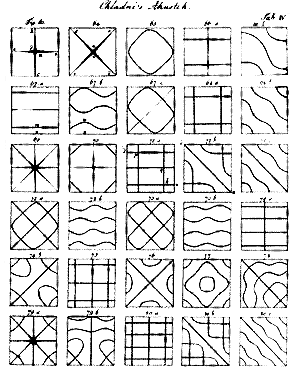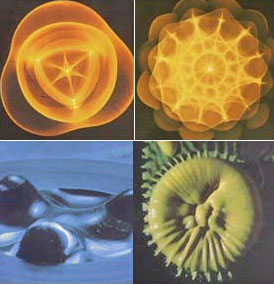|

by Patricia R. Spadaro
2005
from
Cymatics
Website
Pictures
of Sound: Making Invisible Vibrations Visible
In our modern culture, where for many seeing is believing, how do we
know that what sages and energy practitioners say about the power of
sound is true? Is there evidence that vibration and sound can affect
matter, interact with our molecules and stimulate healing? And if
so, can we measure their effects?
In the eighteenth-century, German scientist and musician Ernst Chladni, known as the father of acoustics, took a step toward
answering these questions. He demonstrated, in simple, visual
experiments, that sound affects matter. When he drew a violin bow
around the edge of a plate covered with fine sand, the sand formed
various geometric patterns, as shown below.

Another pioneer in this arena was Dr.
Hans Jenny. A Swiss medical doctor and a scientist, Dr. Jenny
realized the importance of vibration and sound and set out to study
them from a unique angle. His fascinating experiments into the study
of wave phenomena, which he called cymatics (from the Greek kyma,
meaning “wave”), provide nothing less than pictures of how sound
influences matter.
In the 1960s, Dr. Jenny placed sand, fluid and powders on metal
plates, which he vibrated with a special frequency generator and a
speaker. His experiments produced beautiful and intricate patterns
that were unique to each individual vibration (see photographs
below). Moreover, these varying patterns remained intact as long as
the sound pulsed through the substance. If the sound stopped, the
pattern collapsed. For many, these experiments show that sound can
indeed alter form, that different frequencies produce different
results, and that sound actually creates and maintains form.
The photographs
below are taken from Dr. Jenny's work in cymatics.
Used with
permission from the two-volume edition of Cymatics: A Study of Wave
Phenomena
MACROmedia, 219 Grant Road, Newmarket, NH 03857.
www.cymaticsource.com.

Although best known for his stunning cymatic images,
Dr. Jenny was also an artist and musician as well as
a philosopher, historian and physical scientist. Perhaps most
important, he was a serious student of nature’s ways with keen
powers of observation. Whether it was the cycle of the seasons, a
bird’s feathers, a rain drop, the formation of weather patterns,
mountains or ocean waves—or even poetry, the periodic table, music
or social systems—Dr. Jenny saw an underlying, unifying theme: wave
patterns, produced by vibration.
“Wherever we look, we can describe
what we see in terms of periodicities and rhythmicities,” he
wrote. “When nature creates anything it creates in this periodic
style.”
1 For him, everything reflected inherent patterns of
vibration involving number, proportion and symmetry—what he
called the “harmonic principle.” Dr. Jenny encouraged continuing
research into the wave phenomenon. The purpose of such studies,
he explained, was to “hear” the systems of Nature. “What we want
to do is, as it were, to learn to ‘hear’ the process that
blossoms in flowers, to ‘hear’ embryology in its manifestations
and to apprehend the inwardness of the process,” he wrote.
2
Our Cells
Respond to Sound
The implications of Dr. Jenny’s work are vast, especially for the
field of healing and vibrational medicine. If sound can change
substances, can it alter our interior landscape? Since patterns of
vibration are ubiquitous in nature, what role do they play in
creating and sustaining the cells of our own bodies? How do the vibrational patterns of a diseased body differ from the patterns the
body emanates when it is healthy? And can we turn the unhealthy
vibrations into healthy ones? While Dr. Jenny did not focus on the
healing possibilities of sound and vibration, his work inspired many
whose destiny it was to do just that.
Two other researchers who have created visually compelling evidence
of the power of sound are Japanese scientist
Masaru Emoto and Fabien
Maman. Maman, a French composer, acupuncturist and bioenergetician,
and Helene Grimal, a biologist, experimented with both healthy and
cancer cells to see how they would respond to the voice and to
various instruments. In his book
The Role of Music in the
Twenty-First Century, Maman reports that among the dramatic effects
of sound they captured in their photographs was the progressive
destabilization of the structure of cancer cells. When Maman played
sounds that progressed up the musical scale, the cancer cells
eventually exploded.
Japanese scientist Masaru Emoto showed the potent effects of sound
by
photographing water crystals. In his remarkable experiments, he
played classical music and folk songs from Japan and other countries
through speakers placed next to water samples. He then froze the
water to make crystals and compared the crystalline structure of
different samples. With each musical piece, the water sample formed
different and beautifully geometric crystals. When he played heavy
metal music, the water crystal’s basic hexagonal structure broke
into pieces.
In another experiment, Emoto and three hundred others assembled at
the shore of a badly polluted lake in Japan and spoke aloud an
affirmation of peace and gratitude. The water crystals changed from
a cloudy and distorted image before the prayer to beautiful,
geometric crystals after the prayer. Smaller groups of people have
repeated this experiment at other lakes around the world with
similar results, which Emoto has published in volume two of his
Messages from Water.
Notes
1. Hans Jenny,
Cymatics: A Study of
Wave Phenomena and Vibration (Newmarket, N.H.: MACROmedia,
2001), p. 271
2. Ibid., p. 276
|


